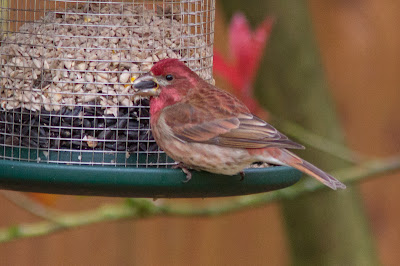Orange-crowned Warblers (above) are a harbinger of spring for much of North America. Here in the Pacific Northwest, Orange-crowns begin to make their way through between mid-March and early April. The individual pictured above was photographed on Easter morning (April 8th) which, as we'll show later, was a heck of a morning for local movement. The migratory wave that brought this individual to the yard was about a week later than usual.
Early- and mid-April have also brought us a large movement of Ruby-crowned Kinglets. These diminutive, hyperactive birds winter in the Willamette Valley and make their annual pilgrimage to the Cascades and surrounding foothills at this time of the year. The local movement this season seemed unusually high, with over 70 individuals reported at a popular birding location in town last week. They were omnipresent for much of the first week and a half of the month in my yard, with three individuals spotted in my cherry tree just a couple of days ago.
This male Ruby-crowned Kinglet works one of the neighbor's trees
A male Rufous Hummingbird cautiously waits for me to go back inside before returning to the nectar feeder.
Rufous Hummingbirds, first spotted way back during the second week of March, have continued to make their way through since the beginning of the month. Females predominated at the end of March and early April, but males have had a more-or-less equal showing since. Rufous Hummingbirds have historically disappeared from my yard by mid-May (presumably not breeding in the area), but hopefully that changes this year.
Migratory sparrows have also been coming through. Last week, a trio of "Gambel's" subspecies White-crowned Sparrows (subspecies gambelli) made an appearance in the yard (thanks to Dave Irons for the subspecies ID). This subspecies winters in the Southwest and breeds in Western Canada and Alaska. Thus, they are strictly migratory in our neck of the woods. (Conversely, our typical winter vistors, the pugetensis subspecies, are year-round residents.) Two Gambel's WC Sparrows were in the yard yesterday, accompanied by one of our overwintering White-throated Sparrows. A Golden-crowned Sparrow (almost done molting into breeding plumage) was scratching around for seed beneath the feeders this morning. This Golden-crown, who also breeds in Western Alaska and Canada, will likely make its way north soon. A Fox Sparrow (not shown) was also spotted in the yard last week.
This migatory "Gambel's" White-crowned Sparrow can be differentiated from the local pugetensis subspecies, in part, by the bright white spots on its upper back, its thin black post-ocular stripe, and the very limited amount of dark coloring at the tip of its otherwise corn-yellow bill.
A molting and soon-to-be migrating Golden-crowned Sparrow stops in for a snack
Our most abundant sparrow, the Dark-eyed Junco, is also on its way out. Though not migratory in the true sense (in fact, a small number breed locally), most breed in the Cascade foothills. A week ago, I could easily count a half dozen in the yard. Now, I have two remaining individuals. I imagine that they'll be gone by this time next week.
Local (non-migratory) movement is also big at this time of the year. Many species of birds winter in the lowland urban areas and breed in the forests just outside of town. On Eastern morning, we were blessed (no pun intended) by two of my favorites: Evening Grosbeaks (above) and Purple Finches. Evening Grosbeaks have been flocking around town for most of the first half of the month. At the beginning of the month, there was a flock of almost 30 split between our large Black Walnut and one of my neighbor's trees. The following weekend, two females and a male came down to feed in the yard. Just a few minutes later, a lone male Purple Finch began snacking at the same feeder. April is a good time to see both species (Evening Grosbeaks tend to hang out here a little longer, into mid-May)
A male Purple Finch with a mouthfull of sunflower
Pine Siskins continue to hang around in flocks of 15-20. Though they typically breed in the coniferous forests of the Cascades and surrounding foothills, some tend to hang around and breed locally (especially after an irruptive winter).
The large flocks of Pine Siskins (above) finally caught the eye of the local Accipiters (small hawks). Both Sharp-shinned and Cooper's Hawks have been making the rounds recently. Our local female Cooper's (below) has been especially aggressive, hunting in the yard multiple times over the past week. She was even accommodating enough to give my rather loud two-year-old a good look...
In the midst of migratory madness, we would be remiss to omit a discussion of our year-round locals. Anna's Hummers are still in shorter-than-usual supply due to the wet weather, but are still hanging around and resisting the migratory surge of the notoriously-aggressive Rufous Hummers. Northern Flickers seem to have left for their woodland breeding grounds, but I'm still seeing a fair number of Downy Woodpeckers at the suet feeders. Bushtits and Black-capped Chickadees - both local breeders - continue to represent in typical numbers. American Goldfinches, greatly underrepresented this winter, have made something of a comeback. And that's great, because the males look marvelous in their breeding plumage.
A female Downy Woodpecker stops in for some suet
This mostly-molted male American Goldfinch looks great in its breeding plumage. I hope to see more of them this summer.
I love ending with a nice, bright American Goldfinch. They're a beacon of better weather to come in a sea of overcast skies.
It's supposed to be warm and sunny this weekend, with highs in the 70s. And that means more migrants! Black-throated Gray Warblers have made their way into town and will probably appear in the yard soon. We may also see our first-of-the-season Nashville Warblers and Cassin's Vireos soon as well. And we're about two weeks away from our first-of-the-season Black-headed Grosbeak. What an exciting time. Until then, good birding...











No comments:
Post a Comment